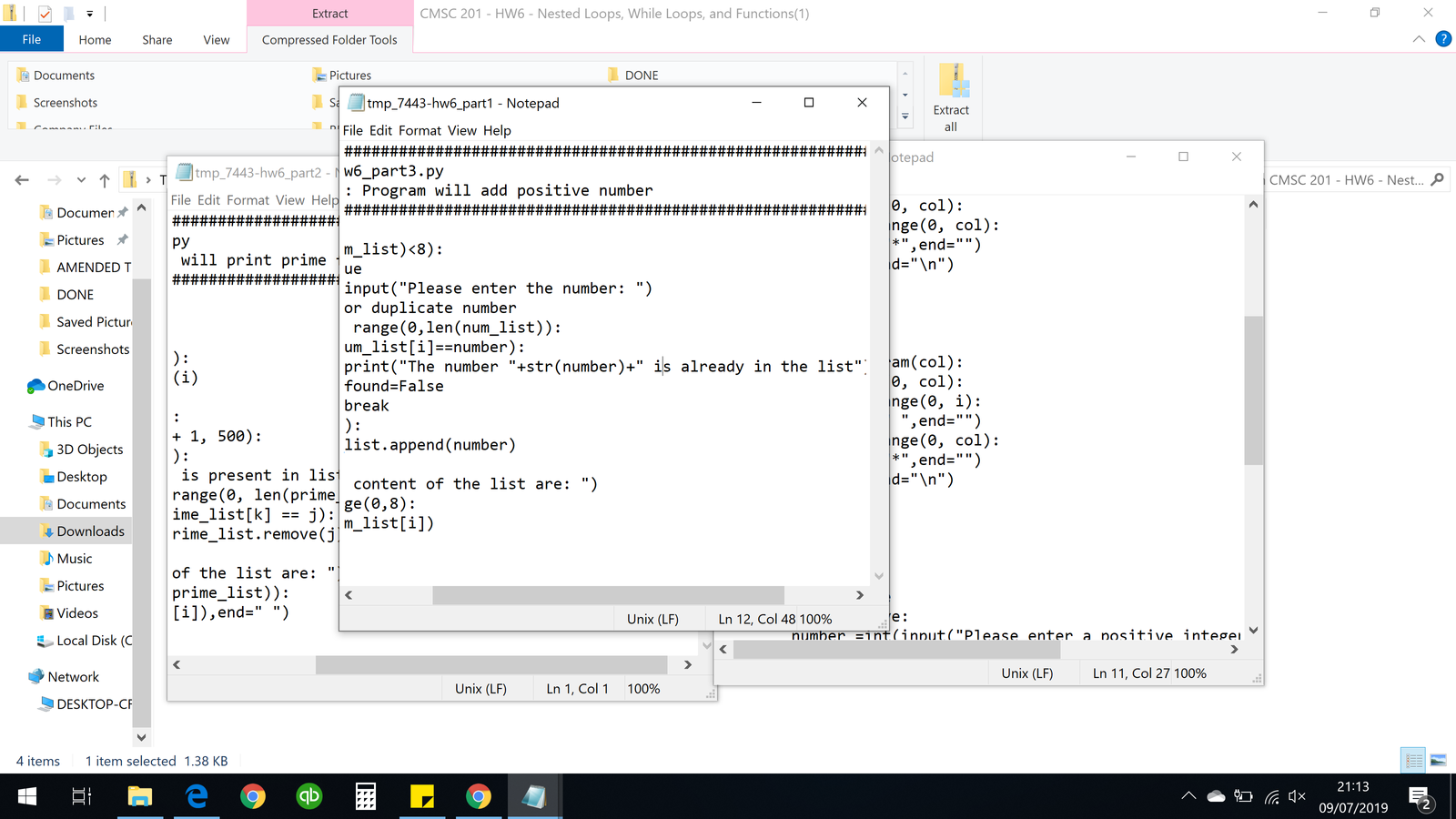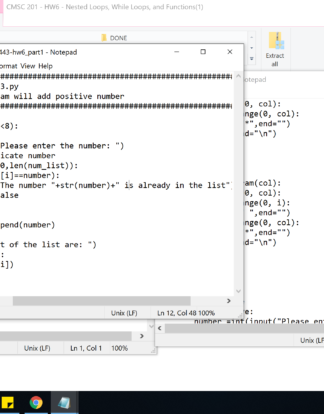Description
Homework 6 is designed to help you practice using while loops, nested
loops, lists, iterating over lists, branching selection structures, and creating
and calling functions. More importantly, you will be solving problems using
algorithms you create and code yourself.
Remember to enable Python 3 before you run your programs:
scl enable python33 bash
Instructions
In this homework, you will be doing a series of exercises designed to help
you practice using while and for loops, control statements like
if/else, print() statements, and algorithmic thinking. Each one of these
exercises should be in a separate python file. For this assignment, you may
assume that all the input you get will be of the correct type (e.g., if you ask
the user for a whole number, they will give you an integer).
For this assignment, you’ll need to follow the class coding standards, a
set of rules designed to make your code clear and readable. The class coding
standards are on Blackboard under “Course Documents” in a file titled
“CMSC 201 – Python Coding Standards.”
You should be commenting your code, and using constants in your
code (not magic numbers or strings). Re-read the coding standards!
You will lose major points if you do not following the 201 coding standards.
A very important piece of following the coding standards is writing a complete
file header comment block. Make sure that each file has a comment block
at the top (see the coding standards document for an example).
NOTE: You must use main() in each of your files.
CMSC 201 – Computer Science I for Majors Page 2
Details
Homework 6 is broken up into three parts. Make sure to complete all 3 parts.
NOTE: Your filenames for this homework must match
the given ones exactly.
And remember, filenames are case sensitive.
You must run and test your code before submitting!
Code that does not run will lose a significant number of points.
hw6_part1.py (Worth 10 points)
Write a program that reads in numbers from the user and adds them to a list.
There should be no duplicate numbers in the list – if the user attempts to add a
number already contained in the list, print a short error message and prompt
them again.
Once the list contains eight numbers, the program should stop prompting and
print out the contents of the list.
You may not use any of Python’s other built-in functions. You may not
use a line of code that uses the “in” keyword to check if a number is
already contained in the list. You will lose major points if you do so!
(You should instead use a for loop to iterate over and check the contents.)
A sample run is available on the following page.
CMSC 201 – Computer Science I for Majors Page 3
Here is some sample output for hw6_part1.py, with the user input in blue.
bash-4.1$ python hw6_part1.py
Please enter a number: 9
Please enter a number: 9
The number 9 is already in the list
Please enter a number: 5
Please enter a number: 1
Please enter a number: 33
Please enter a number: -7
Please enter a number: -44
Please enter a number: 0
Please enter a number: 5
The number 5 is already in the list
Please enter a number: 9
The number 9 is already in the list
Please enter a number: 6
The contents of the list are:
9
5
1
33
-7
-44
0
6
CMSC 201 – Computer Science I for Majors Page 4
hw6_part2.py (Worth 10 points)
(WARNING: This part of the homework is the most challenging, so budget
plenty of time and brain power. And read the instructions carefully!)
Next you will write a program that uses a very simple algorithm to compute
the prime numbers up to 500.
Your program should start by creating a list of numbers from 2 to 500. (Do
not hard code a list of 500 number!)
Next, it should remove all of the multiples of 2 from the list, not including 2 (so
it should remove 4, 6, 8, 10, etc., but should not remove 2). Remember the
remove() function we covered in lecture!
It should do the same for 3, 4, 5, etc., all the way up to 25. (Again, you
should not hard code – do not create a separate loop for each of the
numbers from 2 to 25!)
Once it is done, you should print the values remaining in the list. (They
should all be prime numbers, since we’ve removed all of the multiples!)
Here is some sample output.
bash-4.1$ python hw6_part2.py
2 3 5 7 11 13 17 19 23 29 31 37 41 43 47 53 59 61 67 71
73 79 83 89 97 101 103 107 109 113 127 131 137 139 149
151 157 163 167 173 179 181 191 193 197 199 211 223 227
229 233 239 241 251 257 263 269 271 277 281 283 293 307
311 313 317 331 337 347 349 353 359 367 373 379 383 389
397 401 409 419 421 431 433 439 443 449 457 461 463 467
479 487 491 499
In the sample output, all of the numbers are printed on the same line. One
way to do this yourself is to use something like the line of code below, which
replaces the new line that print() normally puts at the end of each print
statement with a single space.
print(number, end = ” “)
CMSC 201 – Computer Science I for Majors Page 5
hw6_part3.py (Worth 16 points)
Your last task is to write a program that uses functions to draw a triangle, a
square, a parallelogram, or all three shapes, as chosen by the user.
Your program should contain four functions:
1.main()
Gets a positive integer (greater than 0) as input from the user
o Reprompts until the user enters a positive integer
Asks the user to choose which shape: “triangle”, “parallelogram”,
“square”, or “all” to select all three shapes
o Reprompts until the user enters a valid choice
Calls the appropriate function(s) to print what the user requested
2.drawTriangle()
Takes in an integer as a formal parameter, and draws a solid
right-angle triangle (made of asterisks) of that height and width
3.drawSquare()
Takes in an integer as a formal parameter, and draws a solid
square (made of asterisks) of that height and width
4.drawParallelogram()
Takes in an integer as a formal parameter, and draws a solid
parallelogram (made of asterisks) of that height and width; the
parallelogram should be offset by one character for each line
Here is some sample output, with the user input in blue. Additional sample
output can be found on the following page.
bash-4.1$ python hw6_part3.py
Please enter a positive integer: -1
Please enter a positive integer: -7
Please enter a positive integer: 0
Please enter a positive integer: 5
Please choose the shape: square, parallelogram, triangle,
or all: parallelogram
*****
*****
*****
*****
*****
CMSC 201 – Computer Science I for Majors Page 6
Additional sample output for hw6_part3.py, with the user input in blue.
bash-4.1$ python hw6_part3.py
Please enter a positive integer: 4
Please choose the shape: square, parallelogram, triangle,
or all: squaree
Please choose the shape: square, parallelogram, triangle,
or all: square
****
****
****
****
bash-4.1$ python hw6_part3.py
Please enter a positive integer: 2
Please choose the shape: square, parallelogram, triangle,
or all: triangle
*
**
bash-4.1$ python hw6_part3.py
Please enter a positive integer: 5
Please choose the shape: square, parallelogram, triangle,
or all: all
*****
*****
*****
*****
*****
*****
*****
*****
*****
*****
*
**
***
****
*****
CMSC 201 – Computer Science I for Majors Page 7
Submitting
Once all three parts of your Homework 6 are complete, it is time to turn them
in with the submit command.
Don’t forget to complete the header block comment for each file! Make sure
that you updated the header block’s file name and description for each file.
You must be logged into your GL account, and you must be in the same
directory as the Homework 6 files. To double check this, you can type ls.
linux1[3]% ls
hw6_part1.py hw6_part2.py hw6_part3.py
linux1[4]% █
To submit your files, we use the submit command, where the class is
cs201, and the assignment is HW6. Type in (all on one line)
submit cs201 HW6 hw6_part1.py hw6_part2.py hw6_part3.py
and press enter.
linux1[4]% submit cs201 HW6 hw6_part1.py hw6_part2.py
hw6_part3.py
Submitting hw6_part1.py…OK
Submitting hw6_part2.py…OK
Submitting hw6_part3.py…OK
linux1[5]% █
If you don’t get a confirmation like the one above, check that you have not
made any typos or errors in the command.
You can double-check that all three homework files were submitted by
using the submitls command. Type in submitls cs201 HW6 and hit
enter.
And you’re done!




